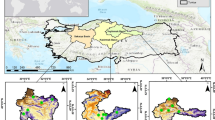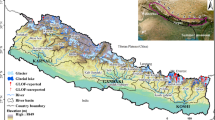Abstract
Water temperature (WT) is one of the important indicators of water body physical properties. Understanding the characteristics of spatial-temporal variation on WT in the river continuum will help to develop the rational river-water-resource utilization plan, to avoid the possible ecology crisis, and to take full advantages of the natural resources in the involved region. As the biggest international river continuum in Asia, the Lancang-Mekong river subregion (known as Greater Mekong Subregion, GMS) has become a famous economic, political, and ecological natural territory. This study examined the spatial-temporal distribution characteristics of the Lancang River water temperature, using the observational data of WT values from 11 hydrological stations in 1960s. Furthermore, the WT differences between Yunjinghong hydrological station (one representative station in China) and Chiang Saen hydrological station (one representative station in Thailand) were analyzed. Results indicated that: 1) Water temperature was higher in the lower part of the river continuum than the upper part. Latitude variation is the main influencing factor. This effect is more obvious in dry season than in rainy season, more obvious in winter than in summer, and more obvious of the average minimum WT than the average maximum WT; 2) WT difference between the upper and the lower parts of the river continuum was decreasing due to little increase of WT in the upper part (Yunjinghong hydrological station) and obvious decrease of the WT in the lower part (Chiang Saen hydrological station) during the research period. Therefore, the parameters of WT are affected by the latitude, and the Lancang-Mekong river continuum lies in the north-south direction, so the tropical aquatic creatures, such as the tropical aquatic fishes, cannot survive in the upper part of this river continuum in winter season, while in summer season, the tropical aquatic creatures properly swim to the upper stream. The water temperature in the lower Mekong River is mainly influenced by the regional water temperature and regional climate change.
Similar content being viewed by others
References
Chen L H, Zeng Z G, He D M. Coordinating the relationships between interest parties in development of the international river—A case study of Lancang-Mekong. World Regional Studies (in Chinese with English abstract), 2003, 12(1): 71–78
Feng Y, He D M, Gan S. Analysis on the shanges of water resource system of the Lancang River and its impacts to Great Mekong Sub-regional cooperation. World Regional Studies (in Chinese with English abstract), 2005, 14(4): 49–56
Feng Y, He D M, Gan S et al. Linkages of transboundary water allocation and its eco-thresholds with international laws. Chin Sci Bull, 2006, 51(Suppl.): 25–32
Zhou W, Han L X. Fish resource conservation and sustainable utilization in Lancang River system, Yunnan Province. In: Biodiversity Committee of Chinese Academy of Sciences, ed. China Biodiversity Conservation in the 21st Century (in Chinese). Beijing: China Forestry Press, 1999. 282–288
Zhou W. A preliminary study on endangerment mechanism of freshwater fish species in wetland ecosystem of Yunnan. Biodiv Sci (in Chinese with English abstract), 2000, 8(2): 163–168
He D M, Wu S H, Peng H, et al. A study of ecosystem changes in Longitudinal range-gorge region and trans-boundary eco-security in Southwest China. Adv Earth Sci (in Chinese with English abstract) 2005, 20(3): 338–344
He Y L, Zhang Y P. The climate characteristics and change trends on basins of Lancang valley in Yunnan Province. J Mountain Res (in Chinese with English abstract), 2004, 22(5): 539–548
He Y L, Zhang Y P. Climate change from 1960 to 2000 in the Lancang River Valley, China. Mountain Rese Dev, 2005, 25(4): 341–348
You W G, He D M, Guo Z R. Correlation characteristics between Lancang River flow change and precipitation field change in Yunnan. Sci Geogr Sin (in Chinese with English abstract), 2005, 25(4): 420–426
He S P, Wang W, Chen Y R, et al. The preliminary investigation on fish biodiversity in middle and upper reach of Lancangjiang river. Yunnan Geogr Environ Res (in Chinese with English abstract), 1999, 11(1): 26–29
Yao W K, Cui B S, Dong S K, et al. Spatio-temporal characteristics of Lancangjiang River water temperatures along the representative reaches disturbed by hydroelectric power projects. Acta Sci Circumst (in Chinese with English abstract), 2006, 26(6): 1031–1037
Mohseni O, Stefan H G. Stream temperature/air temperature relationship: A physical interpretation. J Hydrol, 1999, 218: 128–141
O’Brien C M, Fox C J, Planque B, et al. Fisheries-climate variability and North Sea cod. Nature, 2000, 404: 142–142
Livingstone D M, Lotter A F. The relationship between air and water temperatures in lakes of the Swiss Plateau: A case study with palaeo-limnological implications. J Paleolimnol, 1998, 19: 181–198
Benson B J, Lenters J D, Magnuson J J, et al. Regional coherence of climatic and lake thermal variables of four lake districts in the upper Great Lakes region of North America. Freshwater Biol, 2000, 43: 517–527
Meier W, Bonjour C, Wüest A, et al. Modeling the effect of water diversion on the temperature of mountain streams. J Environ Eng—ASCE, 2003, 129: 755–764
Baines S B, Webster K E, Kratz T K et al. Synchronous behavior of temperature, calcium, and chlorophyll in lakes of northern Wisconsin. Ecology, 2000, 81, 815–825
Magnuson J J, Benson B J, Kratz T K. Temporal coherence in the limnology of a suite of lakes in Wisconsin, USA. Freshwater Biol, 1990, 23: 145–159
Milner N J, Elliott J M, Armstrong J D, et al. The natural control of salmon and trout populations in streams. Fish Res, 2003, 62: 111–125
Rahel F J, Keleher C J, Anderson J L. Potential habitat loss and population fragmentation for cold water fish in the North Platte River drainage of the Rocky Mountains: Response to climate warming. Limnol Oceanogr, 1996, 41: 1116–1123
Reid P C, Borges M D, Svendsen E. A regime shift in the North Sea circa 1988 linked to changes in the North Sea horse mackerel fishery. Fish Res, 2001, 50: 163–171
Hari R E, Livingstone D M, Siber R, et al. Consequences of climatic change for water temperature and brown trout populations in Alpine rivers and streams. Global Change Biol, 2006, 12: 10–26
Matthews W J, Zimmerman E G. Potential effects of global warming on native fishes of the southern Great Plains and the Southwest. Fisheries, 1990, 15: 26–32
Author information
Authors and Affiliations
Corresponding author
Additional information
Supported by the National Key Project for Basic Research on Ecosystem Changes in the Longitudinal Range-Gorge Region and Transboundary Eco-security of Southwest China (Grant No. 2003CB415101)
About this article
Cite this article
Zhang, Y., Gao, F., He, D. et al. Comparison of spatial-temporal distribution characteristics of water temperatures between Lancang River and Mekong River. Chin. Sci. Bull. 52 (Suppl 2), 141–147 (2007). https://doi.org/10.1007/s11434-007-7008-2
Received:
Accepted:
Issue Date:
DOI: https://doi.org/10.1007/s11434-007-7008-2




